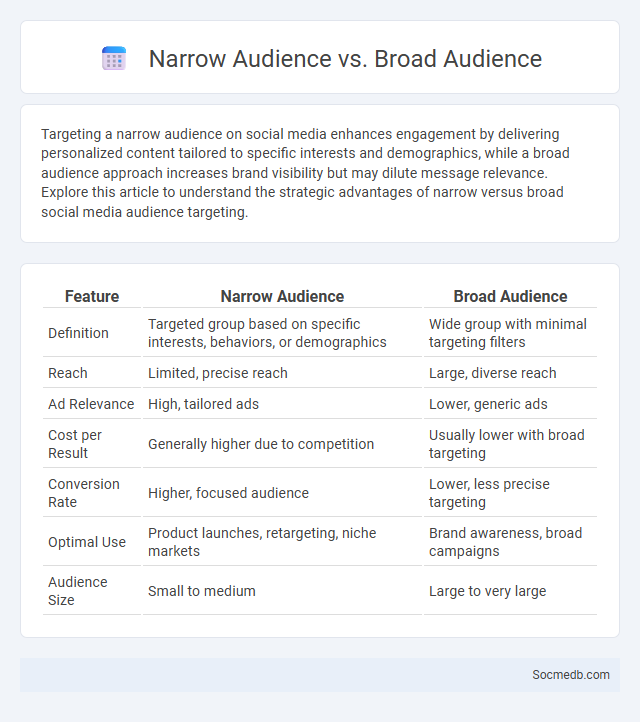
Photo illustration: Narrow Audience vs Broad Audience
Targeting a narrow audience on social media enhances engagement by delivering personalized content tailored to specific interests and demographics, while a broad audience approach increases brand visibility but may dilute message relevance. Explore this article to understand the strategic advantages of narrow versus broad social media audience targeting.
Table of Comparison
| Feature | Narrow Audience | Broad Audience |
|---|---|---|
| Definition | Targeted group based on specific interests, behaviors, or demographics | Wide group with minimal targeting filters |
| Reach | Limited, precise reach | Large, diverse reach |
| Ad Relevance | High, tailored ads | Lower, generic ads |
| Cost per Result | Generally higher due to competition | Usually lower with broad targeting |
| Conversion Rate | Higher, focused audience | Lower, less precise targeting |
| Optimal Use | Product launches, retargeting, niche markets | Brand awareness, broad campaigns |
| Audience Size | Small to medium | Large to very large |
Understanding Audience Types: Narrow, Broad, and Target
Social media audience types include narrow, broad, and target categories, each influencing content strategy and engagement metrics differently. Narrow audiences consist of specific groups defined by precise demographics or interests, optimizing personalized marketing and higher conversion rates. Broad audiences encompass larger, more generalized groups, increasing reach but requiring adaptable messaging to maintain relevance and engagement.
Defining Narrow Audience: Characteristics and Examples
Defining a narrow audience involves identifying specific characteristics such as age, location, interests, and purchasing behavior to ensure targeted social media marketing campaigns. For example, a brand promoting eco-friendly skincare products may focus on environmentally conscious women aged 25-34 living in urban areas. Your ability to accurately pinpoint and engage this audience can significantly enhance conversion rates and campaign effectiveness on platforms like Instagram and Facebook.
Broad Audience Explained: Reach and Diversity
Social media platforms enable your content to reach a broad audience by leveraging diverse user demographics, interests, and geographic locations, maximizing engagement potential. Algorithms optimize content distribution to target specific segments while exposing it to a wide array of users, enhancing visibility and brand awareness. Understanding this reach and diversity allows you to tailor strategies that resonate with varied groups, driving more meaningful interactions and growth.
What is a Target Audience? Key Points and Importance
A target audience is a specific group of people identified by demographics, interests, behaviors, and needs that a brand aims to reach through social media marketing efforts. Understanding the target audience allows businesses to create tailored content, increase engagement, and improve conversion rates by addressing the precise preferences and challenges of their ideal customers. Effective targeting reduces ad spend waste and enhances campaign performance by delivering relevant messages to the most receptive users on platforms like Facebook, Instagram, and Twitter.
Benefits of Focusing on a Narrow Audience
Focusing on a narrow audience in social media marketing enhances engagement rates by delivering highly relevant content tailored to specific interests and needs. This strategy improves conversion rates as targeted messaging increases the likelihood of user actions such as clicks, shares, and purchases. Brands benefit from stronger community building and customer loyalty by addressing niche markets with personalized experiences and targeted communication.
Advantages and Challenges of a Broad Audience
Social media platforms offer the advantage of reaching a broad audience, enabling businesses and individuals to expand their brand visibility and engage with diverse demographics worldwide. This extensive reach facilitates real-time feedback and viral marketing opportunities, boosting customer interaction and sales potential. However, managing a vast audience poses challenges such as maintaining consistent messaging, addressing varied cultural sensitivities, and handling increased scrutiny or negative feedback efficiently.
How to Identify Your Target Audience
To identify your target audience on social media, analyze demographic data such as age, gender, location, and interests using platform analytics tools like Facebook Insights or Instagram Audience Insights. Conduct surveys and engage with existing followers to gather qualitative information about their preferences, pain points, and behaviors. Utilize competitor analysis to understand which audiences interact with similar brands and tailor your content strategy to meet their specific needs and expectations.
Narrow vs Broad Audience: Key Differences
Targeting a narrow audience on social media allows you to create highly personalized content that resonates with specific interests, increasing engagement and conversion rates. Broad audience strategies aim to maximize reach and brand awareness but often result in lower interaction due to diverse interests and preferences. Understanding these key differences helps optimize your social media campaigns for better ROI by aligning content with the right audience scope.
Building Effective Marketing Strategies for Each Audience Type
Tailoring marketing strategies to specific audience types on social media boosts engagement and conversion rates. Utilizing data analytics to segment users by demographics, interests, and online behavior enables precise content targeting. Employing platform-specific features like Instagram Stories for millennials or LinkedIn articles for professionals enhances message relevance and campaign effectiveness.
Choosing the Right Audience Approach for Your Brand
Choosing the right audience approach for your brand on social media involves analyzing demographic data, user behavior, and engagement patterns to target the most relevant segments effectively. Leveraging advanced analytics tools helps you identify potential customers and tailor content that resonates with their interests and needs. Understanding your audience's preferences increases brand visibility and drives meaningful interactions.
 socmedb.com
socmedb.com